Now Available in updated paperback, the most comprehensive book on climate change science, effects and what to do about it.
An updated paperback edition of Earth Under Fire is now available in stores and for on-line ordering.
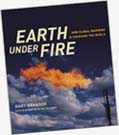 Earth Under Fire: How Global Warming is Changing the World is a comprehensive look at the world wide effects of climate change, its implications, and what action is being taken about it. In dramatic photographs and quotes from world climate science leaders, this book shows how the earth is being changed right now. Earth Under Fire ends with a vision of how we can slow global warming and improve the lives of people everywhere. Al Gore says: "The power of Gary Braasch's personal witness to the climate crisis makes this essential reading for every citizen."
Earth Under Fire: How Global Warming is Changing the World is a comprehensive look at the world wide effects of climate change, its implications, and what action is being taken about it. In dramatic photographs and quotes from world climate science leaders, this book shows how the earth is being changed right now. Earth Under Fire ends with a vision of how we can slow global warming and improve the lives of people everywhere. Al Gore says: "The power of Gary Braasch's personal witness to the climate crisis makes this essential reading for every citizen."
Chosen one of the 50 Best Environmental Books and Media by Vanity Fair
Information and preview at earthunderfire.com
Climate Communications Journal Article (PDF)
 Read about Gary Braasch's experiences in documenting climate change, and how to best communicate with the public and politicians. Science ideas should be more visible in society, he says, and not only from researchers and journalists: "We need more Simpsons, Jon Stewart and symphonies for science."
Read about Gary Braasch's experiences in documenting climate change, and how to best communicate with the public and politicians. Science ideas should be more visible in society, he says, and not only from researchers and journalists: "We need more Simpsons, Jon Stewart and symphonies for science."
The Most Important Things You Can Do about Rapid Climate Change:
1. Understand the Problem, its causes
2. Do Something Today to Reduce Greenhouse Gas Emissions, find solutions
This Web site will help you learn the connection between human-made Carbon Dioxide and rapid climate changes and negative effects around the world. The hard fact is that despite what many nations, companies, cities and people are starting to do to reduce their global warming emissions, the world is putting more CO2 into the air than ever before. The current amount is 385 parts per million (ppm) -- higher than ever in the past 800,000 years.
At the same time, renowned American climatologist Dr. James Hansen of NASA says we already have too much CO2 and other greenhouse gases in the air: "If humanity wishes to preserve a planet similar to that on which civilization developed and to which life on Earth is adapted ... CO2 will need to be reduced from its current 385 ppm to at most 350 ppm."

This is scary and controversial, but Dr. Hansen and others believe we must act fast-- as a world of concerned people and leaders taking every action we can to limit greenhouse emissions. 350.org is a new movement of citizens from around the world which I recommend for its clarity of purpose and worthy goal.
Technologies to Combat Global Warming

In Louisiana, California and Oregon recently, I saw new neighborhoods being built of extra-efficient homes with solar panels, on demand water heaters, LED lighting, strong insulation, smart climate controls, batteries to store electricity for night use and plug-ins for electric vehicles. Said a realtor in Lancaster CA: "Even during our 107 degree heat wave the A/C cycles off."
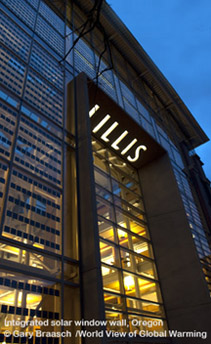
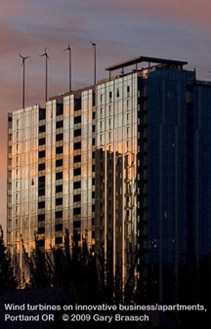
Innovative buildings for education, business and apartments employ wind turbines, high efficiency glass, solar hot water systems, green living roofs, grey water recycling and rainwater harvesting and structural functions which allow natural cooling and warming. Please see 12 West and the Lillis Building sites for more information. Building codes are being changed nationwide to emphasize low-carbon technologies. Photos of many more low-energy choices available. Email or call us please.
Please see Climate News and Views.
Technologies to Combat Global Warming
New solar and wind in California
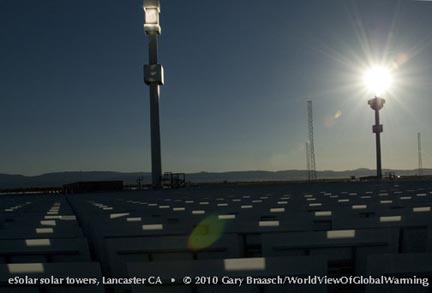
Throughout California and the Southwest, new energy sources are being constructed and connected to the grid. Solar power is burning bright all around southern California and Nevada. The nation's only concentrated solar power station, owned by eSolar in Lancaster CA, focuses the sun on central towers with 20,000 ordinary mirrors, boiling water for a standard GE turbine. The 5 mW plant is a demonstration that this technology, used frequently in Spain and being demonstrated also now in India, is feasible for wide application.
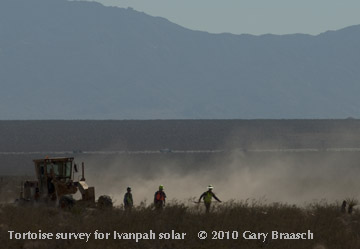
A new set of three similar solar plants is just beginning on BLM land near the Nevada-California border -- and already employs hundreds. The BrightSource Energy installation to provide about 400 mW of power, is on land that is habitat for the California desert tortoise, Federally listed as threatened. So besides 50 fence installers, along with road builders, engineers and security staff being employed, the BLM and the company have 40 biologists patrolling the site to keep tortoises from being killed or injured. Eventually the project will put an average 650 people to work in construction over the coming few years.
The desert tortoises -- an estimated 32 of them live on the solar site -- will be relocated to nearby habitat. During the planning and public comment phase of the project, with input by BLM and NGO endangered species advocates, BrightSource reduced the size of the plant and its footprint to lessen its impact on the land and the tortoises. However, for this and all kinds of energy, we must be humane and far-sighted in where to place installations which will change the land. The habitat for the tortoises and other rare species is limited, so tight concentration of solar installations which leaves lots of open untouched desert land is probably the best solution -- and to reduce the need for giant new installations, we also must have intense local efforts toward using less electricity and local generation of needed power on roofs, parking lots and already-developed land.
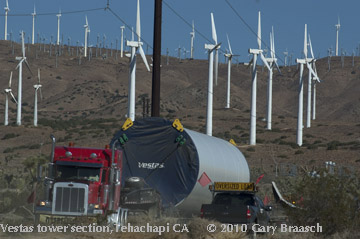
We saw hundreds of people at work on the energy future encouraged by the California climate laws. Truck drivers are delivering huge Vestas wind turbines, and electricians, engineers and crane operators work to install the 300 foot towers for Terra-Gen's vast expansion of the Alta Wind center, Kern County. When completed these 190 turbines made in Pueblo Colorado by Portland Oregon-based Vestas will provide 570 megawatts of power -- and the entire project is estimated to create more than 3,000 mW.
See bottom of this page for other low-carbon energy sources and an example of adaptation to rising sea levels. Other energy issues and solutions will be covered in coming reports, including new housing with solar roofs, energy and water saving technology, and other solar innovations like walls of glass that filter sunlight as well as generate photo-voltaic energy.
DOING OUR PART and TAKING ACTION ON RAPID CLIMATE CHANGE
Sources of information for citizens and educators from the references of Earth Under Fire
 Climate Literacy: The Essential Principles of Climate Science.
Climate Literacy: The Essential Principles of Climate Science.
LINK, high resolution report (11.5 Mb)
A guide is now available to help individuals of all ages understand how climate influences them -- and how they influence climate. A product of the U.S. Climate Change Science Program, it was compiled by an interagency group led by NOAA.
American Council for an Energy-Efficient Economy,
www.aceee.org/consumer/consumer.htm. Tips on home
energy savings and motor vehicle efficiency.
Climate Change Education, www.climatechangeeducation
.org. Links to museums, lesson plans, and other resources
relating to climate change.
Climate Institute, "What You Can Do," www.climate.org/
topics/you/index.shtml. Recommendations for reducing
our environmental footprint.
Earth Day Network, "Climate Change Solutions," www
.earthday.net/resources/2006materials/default.aspx.
Focus the Nation, www.focusthenation.org. Nationwide college
organizing committee on global warming solutions
and political awareness.
National Council of Churches of Christ, www.protecting
creation.org. Interfaith campaign for climate justice.
Vanity Fair, "FiftyWays to Help Save the Planet," www
.vanityfair.com/politics/features/2006/05/savetheplanet
200605.
Weather Channel, "Solutions Library," http://climate.weather
.com
10 MYTHS about Global Warming
Don't believe these commonly heard statements:
* It isn't really happening (documented science overwhelmingly shows temperatures rising rapidly)
* It's natural (temperature increases, especially since the 1970's, are far above natural variations)
* Any effects well be very gradual (not only are severe storms getting stronger, but climate history shows sharp climate changes can occur abruptly, in only a few years)
* It does not affect the U.S. (the U.S. is experiencing rising sea levels, more severe storms and droughts, die-off of forests, altered animal migrations, and loss of glaciers such as those in Glacier National Park)
* It will be good for us (some areas may become more pleasantly warm, but the cost of negative effects will far outweigh any benefits; disease and heat deaths are increasing)
* Agriculture will benefit (CO2 may make some crops grow faster, but also will accelerate weeds, pests and droughts; crops may not grow well where they once did as climate zones shift.)
* It's being handled by our government Changes we make to how we get and use energy will cost billions and throw millions out of work. (There are costs to any change, but study after study shows the net effect of conservation, efficiency and less-polluting energy will be more local jobs, less cost for power, and savings in health and local pollution control. The costs of severe climate change effects like seacoast erosion is far greater than working to reduce them.)
* It's not a big deal compared to national security (Global warming is actually the most serious threat to the widest range of human concerns. Our national and world security is directly threatened by negative climate effects on weather, water supply, disease, agriculture, marine resources, and health)
* Technology will solve the problem for us (Massive "fixes" like burying greenhouse gases are very unlikely, but many smaller changes can make a difference AND are available now)
* There's nothing to be done anyway (Everyone can make a difference today -- SEE BELOW...)
For factual information on common claims and challenges to the science of global warming, please see
the site "Skeptical Science"
ACTIONS
13 Very Important Things to Do about Global Warming...from the individual to the national
1. Learn about it -- start with this Web site and see the References.
2. Sell the SUV and choose cleaner, more efficient vehicles. Reduce your driving: one gallon of gas burned creates 20 pounds of CO2. Slow down for much better mileage. (Avoid biofuels like corn ethanol that can steal food from a hungry world.)
3. Use efficient appliances, replace light bulbs with low-voltage compact fluorescents, check your home insulation. Buy renewable energy, like wind and solar, from your power company.
4. Companies -- the one you work for and the ones you buy from -- can save lots of money and reduce global warming by taking similar steps toward energy efficiency.
5. Shop smart: Look for products made from recycled materials, created with renewable energy, and which help you save money and reduce pollution. Let the corporations who make our cars, fuels, goods and power know you want their products to be as ecological as possible.
6. Use your vote and influence as a citizen to elect responsive leaders; help them organize the neighborhood and town for energy efficiency.
7. Invite neighbors and schools to cooperate in climate cooling actions: Make pathways for walking and biking; put solar panels on roofs; plant community gardens; combine trips or use electric buses for daily errands and kid transport.
8. Suburban sprawl makes for lots of global warming pollution; plan for walkable communities, lots of trees, open spaces, and public transportation in and between cities.
9. Build new homes and buildings for efficiency and solar power.
10. Support sustainable farming and forestry, including non-food crops to make into ethanol and other biofuels
11. At all government levels, develop an efficient energy policy, moving away from fossil fuels and wasteful practices like air shipment of non-urgent parts and products.
12. Export new energy technology for efficiency and renewable energy sources to the rest of the world.
13. ....and start doing these things today.
What can we do?
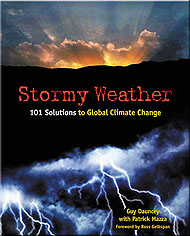
Each of can play a role in dealing with and slowing climate change. Each of us must. Right now, the best source for practical actions that can be adopted by individuals, groups, cities, businesses, and governments is the
book Stormy Weather by Guy Dauncy and Patrick
Mazza, published last year by New Society Publishers. The authors have
a Web site which lists their recommendations, plus a great amount of climate
information, at
http://www.earthfuture.com/stormyweather/
Technologies to Combat Global Warming (first of a series)
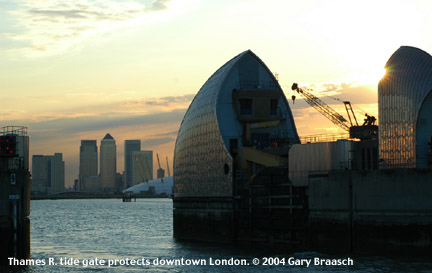 Increasingly
nations and governments have been adopting technologies to deal with global
warming. Some large installations are strictly defensive, like the Thames
River Barrier protecting London, built beginning in 1982. At first it
was used rarely, less than once a year, but British Science Advisor Sir
David King says it is now closed against high tides 6 or 7 times a year.
Increasingly
nations and governments have been adopting technologies to deal with global
warming. Some large installations are strictly defensive, like the Thames
River Barrier protecting London, built beginning in 1982. At first it
was used rarely, less than once a year, but British Science Advisor Sir
David King says it is now closed against high tides 6 or 7 times a year.
Wind turbines are being installed worldwide at an increasing rate. Wind is the fastest growing energy technology in the world today. In recent years, wind capacity worldwide has more than doubled. The towers must be located to protect migrating birds and bats, and scenic landscapes -- which unfortunately early wind farms like Altamont California did not consider. This technology can increase the use and value of open farm and grazing land (see above in Illinois), and is also compatible with solar installations.
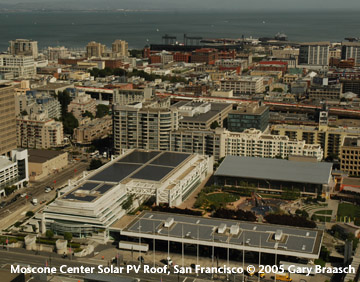 Solar
is also growing and offers the flexibility of scale, from small panels
for individual appliances in homes to huge acreages supplying cities and
industries. The two forms of solar illustrated here are the photovoltaic
panel used in the array on the roof of the Moscone Convention Center in
San Francisco. This is the largest civic owned solar installation in the
US. Its 60,000 square feet generates 675 kilowatts of electricity, and
saves $210,000 a year over conventional electric sources.
Solar
is also growing and offers the flexibility of scale, from small panels
for individual appliances in homes to huge acreages supplying cities and
industries. The two forms of solar illustrated here are the photovoltaic
panel used in the array on the roof of the Moscone Convention Center in
San Francisco. This is the largest civic owned solar installation in the
US. Its 60,000 square feet generates 675 kilowatts of electricity, and
saves $210,000 a year over conventional electric sources.
Another older solar electric generation system is the solar- thermal Kramer Junction array of five fields of 33 megawatts each in the Mojave desert. It has been on line since 1985 to produce electricity for the Southern California Edison power grid supplying the greater Los Angeles area. This technology uses parabolic mirrors to heat an oil which makes steam to run turbines.
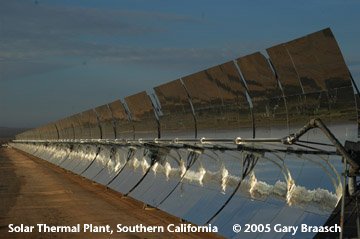 It
must be mentioned that the largest sources of non-fossil fuel energy are
ancient -- water power and wood. These supply most of the so-called renewable
energy in the world despite the obvious negative (and not always renewable
or reversible) effects on rivers and forests. Stay tuned to World View
of Global Warming for increasing details on clean energy solutions and
success stories.
It
must be mentioned that the largest sources of non-fossil fuel energy are
ancient -- water power and wood. These supply most of the so-called renewable
energy in the world despite the obvious negative (and not always renewable
or reversible) effects on rivers and forests. Stay tuned to World View
of Global Warming for increasing details on clean energy solutions and
success stories.
World View of Global Warming is an independent documentary project by photojournalist Gary Braasch, now in its 11th year, presenting a comprehensive look at global warming science, the world wide effects of climate change, its implications, and what action is being taken about it. Braasch documents this change through science reporting and photography from the Arctic to Antarctica, from glaciers to the oceans. Rapid climate change is occurring now and its effects are fast becoming one of the prime events of the 21st century.
Every citizen of the world needs to be aware of rapid climate change:
1. Understand the problem, its causes and threats.
2. Let your leaders know the facts and that you expect them to act.
3. Do something today to reduce greenhouse gas output --
please Take Action
Photographs from the World View of Global Warming are available for license to publications needing science photography, environmental groups and agencies, and other uses. Stock photography and assignments available.
Use of photographs in any manner, in part or whole, without permission is prohibited by US copyright law. These photographs are registered with the US Copyright Office and are not in the Public Domain.
COPYRIGHT NOTICE:
Photography and text Copyright © 2005 - 2017 (and before) Gary Braasch All rights reserved. Use of photographs in any manner without permission is prohibited by US copyright law. Photography is available for license to publications and other uses. Please contact requestinformation@worldviewofglobalwarming.org. View more of Gary Braasch's photography here.


